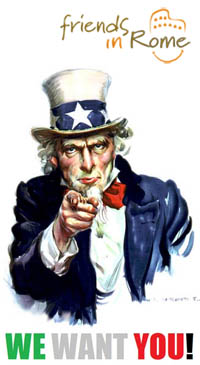12/6/2011 by Mike Dilien Belgium
Authors make cities part and parcel of the world's cultural imagery. Their writings shape the ways in which cities are perceived. Who can stroll on Nevsky Prospekt without thinking of Gogol or Dostoevsky? Though long bygone, herds of tourists still long for Balzac's Paris and Dickens' London. As for Rome, the city knows a long tradition of visitors who write testimonies of their stay in the city: artists, diplomats, aristocrats, higher clergymen… Most of them belonged to the upper classes. They threw parties in spacious "palazzi" and spent their weekends in the countryside. In their accounts, Rome reveals itself as a marvellous place. "Shall I ever forget the sensations I experienced...; when I entered an avenue between terraces and ornamented gates of villas, which leads to the Porto del Popolo, and beheld the square, the domes, the obelisk, the long perspective of streets and palaces opening beyond, all glowing with the vivid red of sunset?" jotted down "England's wealthiest son" (1). Even when reading authors of the likes of Boswell, who describe the rather sordid side of the Eternal City, the reader has to bear in mind that these authors were rather privileged –to them, money was no object.For a more down-to-earth portrayal of the city, one must turn to native writers or writers who not just stayed but actually lived in Rome. Long before the Grand Tourists discovered the remains of the Roman Empire, the son of a freed slave, of all people, praised the greatness of the capital and its empire. It would occur only to a Roman-born to compose sonnets on the city's plebs… in local dialect! And who else but a gay teacher working in the periphery could better portrayal the sexual awakenings of poor adolescent boys?When Italy turned from being a country of emigration to one of immigration, a new kind of author entered the literary scene: immigrants started to publish testimonies of their struggle for life. And they deliberately chose to write in Italian! As the Algerian author Amara Lakhous explains: "When I arrived in Rome in 1995, I learned Italian and started to observe Rome and its citizens because knowing the language and the city is crucial for survival."Mainly because of the language, most of these books were written "four-handed", that is with the help of an Italian author. "Immigrato" (2) written by a Tunisian immigrant, Salah Methnani, and Mario Fortunato, an Italian journalist and author, was one of the first books of its kind.This coming-of-age novel reads like a road movie. As the protagonist travels through Italy, he spends all his money. From being a tourist he turns into an illegal immigrant. Because of his new social and legal status, certain places of the city suddenly seem off-limits. "I could visit the Sistine Chapel and the Vatican museum. I could wander in the Imperial Forums," Methnani writes, "but instead, like all immigrants, I hang around near the Termini station."The city in which the immigrants try to survive seems to be a place different from the one the natives live in and the tourists visit. Methnani evokes an alternative map of the city: "Step by step, I have learnt to recognise the meeting places according to the ethnicities and origins." Different ethnicities having to share the public space is tackled most cunningly in "Scontro di civiltà per un ascensore a piazza Vittorio" (3). With an eye for the detail, Lakhous, a trained anthropologist, delivers a multicultural "giallo" Gadda would be delighted with!Marginalisation is the leitmotif of a highly interesting experiment. The Italian journalist Gabriele del Grande went undercover. In a way of literary method acting, he spent twenty days among Rome's homeless. The result, "Roma senza fissa dimora" (4), is a remarkable piece of journalism. Del Grande tells the city from its basements. In his account, Rome appears to be "a city that excludes".Authors, whether they be ancient or contemporary, foreign or native, can help one to better understand a particular place. Different points of view enrich one's own experience of a place. Whereas artists can draw the attention to the beauty of the patrimony and native authors can reveal the city's hidden treasures, journalists and immigrant authors can show what goes on behind the scenes.Soon, many Italian primary schools will host more immigrant than native children. Piazza Vittorio, with its culturally diverse communities, orchestra and carnival, might well become the symbol of modern, multicultural Italy. It won't come as a surprise to those who have been reading contemporary Italian literature lately!Mike Dilien References(1) William Beckford: "Dreams, waking thoughts, and incidents", Ward, Lock and Co. (London), 1891 (2) Salah Methnani, Mario Fortunato: "Immigrato", Theoria (Roma-Napoli), 1990 (3) Amara Lakhous: "Scontro di civiltà per un ascensore a piazza Vittorio", Edizioni E/O (Roma), 2006 (4) Gabriele del Grande, "Roma senza fissa dimora", Infinito (Roma), 2009



12/6/2011



12/6/2011
